Of
Shrines and Blackmail
Hostage politics is not
restricted to men or captive school children. Shrines have also become a part of
the politics of hostages, especially in the Kashmir valley. Get into a Shrine,
threaten to burn it, place your explosives or incendiaries all along the
building- a charge near the dead saint's tomb or the sacred relic- encircle the
building with mines and the militant starts feeling that he is in the driver's
seat.
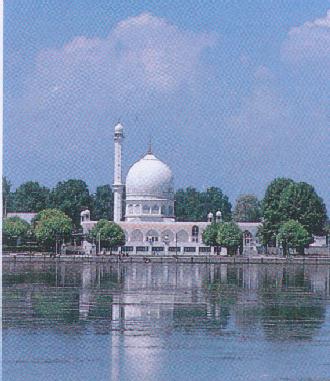
The Hazratbal mosque.
In a country where Akbar went barefoot to Salim Chisti
to ask for the boon of a son, the importance of saints and Peers, and the
respect they are held in, is obviously out of proportion. Indian faith makes no
distinction between a live saint and a dead one. In fact, after the saint's
death, the Shrine gets more importance and acts as a lightning conductor for
religious fervour in the area around. The sick, the childless and the blind
flock to it. Shrines become centres of mass faith. And if something happens to
them, become epicentres of emotional earthquakes. If Shrines are taken over by
terrorist groups, the upheaval and the fears they arouse among the masses can be
better imagined than described.
It is then that the State steps in. It cannot afford
not to act. It cannot be seen immobile or paralyzed or even hostage to other
hostages- men, relics, shrines. The troops will cordon the place off (the enemy
radio will clamour that the troops have laid siege). The ingress and egress
(awful sounding words) to and fro from the building would have to be controlled.
Other restrictions follow. You don't want massive crowds collecting at the
place. It could be dangerous for the crowds. Bullets could start flying after
all. A process leading to some sort of curfew regulation gets initiated. The
situation, bewilderingly, gets translated into a sort of siege.
Guns are loaded. Targets get zeroed and each side
stakes out its territory. Each side lays down its bottom line, marks out its
'yellow lines' and minimum thresholds. Bunkers get sand-bagged. Defences turn up
around the shrine. Wireless sets get crackling. The men in uniform start calling
Police Headquarters, BSF Headquarters, Corps Headquarters and even Delhi.The
terrorists start calling Muzaffrabad, Islamabad and perhaps some fanatic fringe
outfit in Afghanistan. We are in business, Pal. The party has just begun,
government going absolutely hysterical.The Pakistanis even hinted that the whole
crisis had been engineered by India to destabilise the newly formed government
of Benazir Bhutto! On the other hand, there was pressure from right wing parties
in India who thought that government was not being stringent enough with the
militants. The Secretary General of the Organisation of Islamic Conference (OIC),
Mr. Hammid-al-Gabid, a yes-man of Pakistan (on all things Indian), asked India
to refrain from "desecrating the mosque and stop intimidation against those
who frequent the mosque for prayers". But there was not one word against
the militants who had occupied the shrine and whose purpose would have been
served had the Indian forces gone into Hazratbal to flush out the militants and
had the building and the relic got damaged in the process.
THE MECCA INCIDENT
It may be recalled that in November1979, at the start of
the 15th century of the Muslim calendar, the Wahabi preacher, Otaiba, with 250
of his armed followers, entered the sacred Kaaba and gained control over the
mosque. The stand-off lasted for two weeks. The followers of Otaiba wanted to
install him as a Mehdi. French Paratroopers were called in and the whole
incident ended in a blood-bath with over 200 rebels, pilgrims, hostages and
security personnel dying in the gun fight. Not one of the radicals was tried and
yet not one of them is alive. They were obviously executed later. Not a word was
said by the OIC then, though hysterical mobs in Pakistan, for reasons best known
to themselves, burnt the American embassy.
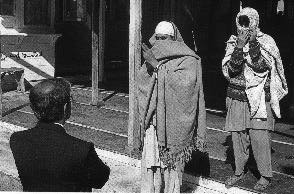
The terrorists at Hazratbal.
In Hazratbal, the militants had barred the entry of the
keeper of the sacred relics, the Imam of the mosque. They literally held an Arms
Exhibition in Hazratbal and later set fire to a part of the premises by setting
off an explosion. The offices of the Auqaf and the guard barracks were gutted
and two firemen, who went to douse the fire, were bashed up. Despite this, the
forces kept their cool and even allowed 35 kgs of meat a day, along with rice,
drinking water etc., to be taken to the militants.
RESOLUTION OF HAZRATBAL
As the Governor, Gen. (retd) K.V. Krishna Rao stated,
after the crisis was over and the surrendered terrorists had been interrogated,
the authorities had unearthed a Pakistani plan to cause damage to shrines in
Kashmir with a view to foment large scale violence in the valley. In pursuance
of this objective, the militants had started setting on fire historical Muslim
shrines one after the other. The Governor added that "The attempt to cause
damage to the holy relic (at Hazratbal) was a part of the same plan, but we were
able to thwart it effectively by taking timely measures".
Through great restraint, the Hazratbal crisis was
resolved and eventually, through Army pressure, the militants surrendered. Two
convicts were jailed and others were bailed out by various Courts. Not a single
shot was fired by the security forces despite great provocation. What is even
more praiseworthy is the fact that the people near the Shrine maintained peace
and tranquillity throughout, and spurned attempts by the militants to rouse
their sentiments.
It must be noted that through September-October 1993
and especially while the confrontation lasted at Hazratbal, numerous attempts
were made by Pakistan-trained Tanzeems to damage various Shrines. On September
21, a Mosque in the vicinity of the historical Maqdoom Shaheb Shrine was gutted
in a fire caused by the militants. Four days later, an attempt was made at night
to set ablaze the famous and historical Naqshband Sahib's shrine in downtown
Srinagar. On September 27, the local Mosque at Kangan was saved by the efforts
of the Fire Brigade when militants had set fire to three houses adjacent to it.
On October 3, an attempt was made on the old Asara-e-Sharief mosque in downtown
Srinagar. On October 23 at Sopore, an attempt was made to damage the Jamia
Masjid when militants set alight a cluster of seven Muslim shops around the
Jamia Masjid. On the same day at Anantnag, they attempted to break open the cash
chest of a popular Muslim shrine, Reshimol Sahib but were foiled by the police
guards. On November 3, an attempl was made to set on fire the famous Maqdoom
Shaheb shrine. This too was foiled by the police guards.
The irony of it is that all this is being done by
militants, some of them mercenaries, who all the time have Islam on their lips,
and who are always masquerading as 'Mujahids' or crusaders in an 'Islamic
cause'.
CHARAR-E-SHERIEF
For Pakistan, Hazratbal was a letdown. If something had
happened to the relic or the Shrine, the Valley would have burnt. Pakistan could
have she crocodile tears and beaten its breast like a professional mourner in
Geneva, in New York and in other conceivable international fora. The quiet
arrangement by which the Hazratbal stand-off was terminated with no explosions
or pyrotechnics, was certainly not to Pakistan's taste. The Charar-e-Sharief
Shrine was definitely an attraction for the warped masterminds of Pakistani
intelligence. It was a Shrine holy to both Muslims and Hindus. Sheikh Nooruddin,
after all, was arguably the greatest mystic-saint of Kashmir.
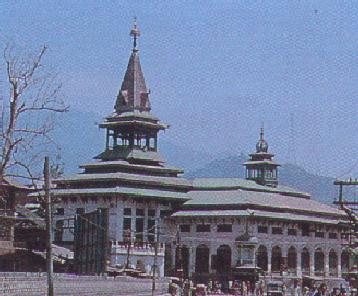
Chrar-e-Sherief.
SHEIKH NURUDDIN
Nothing could better exemplify the composite culture of
Kashmir than the life of Sheikh Naruddin himself. TheSheikh was born as Nund
Reshi or Sahazanand in 1377 AD. His ancestors came from Kishtwar and had
migrated to the Valley. His father, Salar Sanz, a pious man, came under the
spiritual influence of Sufi Saint. Yasman Reshi who arranged his marriage to
Sadra Maji. For three days, the infant Nund is said to have refused to be
breast-fed. The third day, the Yogini, Lal Ded (a very well known saint) entered
the house and put the child's mouth to her own breast.While leaving, she is said
to have called the infant her spiritual heir.
While personifying the Hindu-Muslim culture of the
Valley, Nund, later named Naruddin, 'the light of faith', fully believed in the
immanence and transcendence of God, hoped for a society based on moral values
and preached against indulgence. All his life he wore a coarse pheran. Within
two days of his death in 1438 at Charar, nine lakh people are said to have
gathered at the Shrine, including the King, Sultan Zainul Abdin.
He preached against communal hatred and wrote: "We
belong to the same parents. Then why this difference? Let Hindus and Muslims
together worship God alone. We came to this world like partners. We should
haveshared our joys and sorrows together."
Hence Charar was a Shrine marked out by the ISI. It's
destruction, the ISI thought, would not only cause an upheaval in the Valley but
also effectively burn down a monument to the composite culture of the Valley.
MILITANTS ENTER CHARAR
In the bitter end of 1994-95, militants had started
sneaking into Charar-e- Sharief on their way back from the higher reaches of
Yusmarg. By the third week of January, a sizeable number of militants were
reported in the town. There was talk of as many as two hundred militants in the
area. A Pak mercenary called Mast Gul, trained in Afghanistan, was a part of the
militant team. People sensed a stand-off and the villagers nearby started
migrating, apprehending the heavy presence of militants in the area. By March,
BSF personnel were being fired upon by the militants. On March 7, the Army and
the BSF, who had had enough of it by now, threw a cordon round Charar so that
the militants were denied re-inforcements. Some prominent features around the
town were taken over by the security forces.
People started leaving the town especially when they
learnt that improvised explosive devices (IEDs) were being fabricated by the
militants. The people of the area, as also local militants were enraged when
members of the Harkat-ul-Ansar, the Pak/Afghan outfit, walked into the Shrine
without taking off their footwear.
In fact the locals were apprehensive regarding the fate
of the shrine. According to the Statesman of February 8, 1995 the HuA reached an
understanding with the locals that they would cease to take shelter in the
Shrine once the weather conditions permitted them to re-occupy their secret
camps in the high regions and the forest areas.
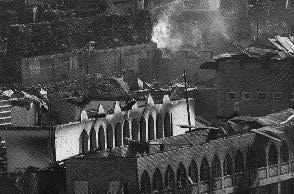
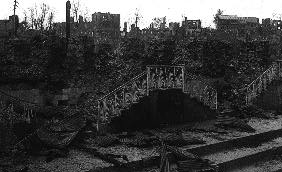
Chrar-e-Sharief after the arson.
By the end of March, even local militants could guess
that the mercenary HuA, under instructions from their Pak mentors, were upto no
good and started distancing themselves from these Pakistani mercenaries.
The security forces were reported to have even offered
a safe passage to Pakistan to the militants through the Suchetgarh border. But
this was not accepted.
Security forces took the necessary stringent steps,
like cutting off water and electricity from the town. By the middle of March,
interception of coded wireless messages exhanged between the militants and their
mentors in Pakistan revealed to the security forces that they had planted IEDs
at the main entrance of Charar-e-Sharief. In fact, they carried out two
underground blasts to test the strength of their explosives. These blasts
frightened the township population. A few hours later they cut off the piped
water supply to the town triggering off a mass exodus of people from the
township.
Hardly a thousand persons stayed behind, out of the
twenty five thousand population of the township. According to a Defence Ministry
Press Release issued from Udhampur on April 4, those left in the town were
either infirm or were staying back to guard their property. When the migrant
families wanted to return, they were abused by the militants and not allowed to
come back.
On May 9, the mercenaries started their campaign of
arson by torching some houses in Badamohalla and the adjacent Fateh Khan and
Ziarat mohallas. While this was taking place, radio intercepts showed the
masters from across the border telling Mast Gul and company "Changa kita;
Ab maza ayega" (Well done; now we will see the fun). The blaze is reported
to have destroyed eight hundred houses and two hundred shops. Two nights later,
the fuze was blown in the confrontation with security forces, and according to
news reports, by 2:30 in the morning, the Shrine itself was set afire along with
the Khanquah (hospice) adjacent to the building. The Mausoleum of Sheikh
Nooruddin, better known as Alam Dar-e-Kashmir which was built by Zain-ul-Abdin
Badshah (1420-1470), who was among the pall bearers of the saint, was reduced to
ashes. Along with the Shrine, hundreds of houses in the Gulshanabad area were
also burnt.
RECEPTlON TO MAST GUL
The criminal Harkat-ul-Ansar had used gas cylinders as
incendiary devices to devastate the Shrine and the town. The last communication
from Mast Gul, the Harkat leader, to his masters across the border stated
"mission khatam kar diya" (mission accomplished). This meant the
Shrine was truly and properly gutted. And the answer, promptly received over the
wirless, said "hum thwade istaqbal ke intezar mein hain" (we are
waiting to welcome you back). And what a welcome it turned out to be from the
moment he stepped on to POK and Pakistani soil! He was lionised and feted, much
to the embarrassment of Pakistani officials. Now why should Mast Gul suddenly
become a hero? Was it merely because he had escaped or was it because his
actions had resulted in the destruction of the Charar Shrine? The answer is not
far to seek. He was lionised for burning the Shrine. According to the Pakistani
press, Mast Gul was in Islamabad on July 30. He addressed a public meeting in
Liaqat Bagh, Rawalpindi on August 4, a meeting also attended by the Pakistani
Jamaat-e-lslami chief, Qazi Hussain Ahmed. In his speech, the Qazi asked the
Pakistan Government to declare a Jehad against India. He stated that the Foreign
Office had criticised the receiptions given to Mast Gul. He attributed this to
the fact that the Pakistani Foreign Office was infected by the "American
virus". He blamed the Government which was trying to dissuade the people
"from fighting a holy war". He also claimed that "public money is
being used to fill the treasury of Asif Ali Zardari and not spent on Defence,
arms and development". Mast Gul stated openly that "the youth of Azad
Kashmir and Pakistan" had "joined hands with their Mujahideen
brethren" to throw the occupation forces out of the Charar-e-Sharief after
the arson Valley. All these clearly show the Pakistan and the Jamaat-e- Islami
hand in this whole sordid drama.
Two comments, as they appeared in the Pakistan press,
would suffice to prove to the hilt how Charar was burnt. According to Jang of
September 23, Sardar Abdul Qayum Khan, Prime Minister of Azad Kashmir, while
addressing a meeting at Lahore on September 22, stated that "some Kashmiris
are of the opinion that Mast Gul himself torched the Shrine and then escaped
from the place." He added that the Kashmiris have also raised objections
that sacrifices are being made by the people of Kashmir, but "Must Gul is
hogging the publicity in Kashmir." The second statement came in an article
by A.S. Yousufi in Dawn of October 10, 1995 datelined Peshwar, which derided the
fact that the Jamaat-e-Islami is "consistently presenting Mast Gul before
the people as a "Ghazi" who risked his life and fought several battles
with the Indian Army. Mast Gul has been brandishing arms, and he was taken
almost to every corner of the NWFP, so that it burns and the people hold the
troops responsible for the damage. The despicable thing about this new politics
of terrorism is that anything really aesthetic or sacred or vulnerable can
suddenly find itself at the end of the barrel of a gun, or next to a live fuse.
A knife at the throat of a child, a loaded pistol at the temple of a captive
woman or an explosive device or the grave of a saint are of the same ilk.
|



















No one has commented yet. Be the first!